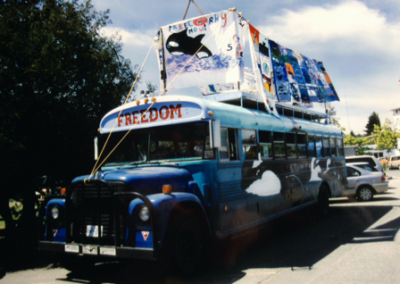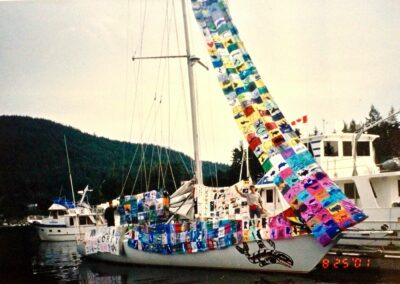Corky
Corky the Survivor
Corky is the longest surviving captive orca whale in the world – 52 years in a concrete tank. She was captured along with other members of her A5 pod family in 1969 in Pender Harbour, British Columbia. The A5 pod, part of the northern resident orcas, was devastated, as 13 members were taken into captivity in two captures in 1968-69. In addition, 63 orcas of the northern and southern resident orcas of the Pacific Northwest were captured in a 13 year period in the 1960-70’s. The southern residents of the Puget Sound area have still not recovered, are down to only 75 whales, and are listed as highly endangered. The northern residents of British Columbia have recovered well, numbering a little over 300 whales, and Corky’s A5 pod has grown to 16 whales in the wild.
All 12 of Corky’s other captured family members died long ago in captivity. Sonny, one of the fishermen who was on the capture team, now has serious regrets about the capture, saying, “If I had to do it over, I wouldn’t do it.”


4 year old Corky, possibly with her mother during the capture
Corky was only 4 years old when she was taken from her mother, and transported to Marineland in Los Angeles and trained to perform Killer Whale shows. Two others of her pod that were taken with her to Marineland soon died, leaving her alone with Orky, a male cousin she then mated with. Corky delivered the first ever live birth of an orca in captivity, but the calf failed to nurse and died at 11 days old. Corky had six more babies, some stillborn, and the longest lived was only for 46 days. Corky stopped ovulating at 21 years. In the wild, female orcas would have about 25 years of reproductive life.
In 1987, Corky was moved with Orky to SeaWorld San Diego, where Orky fathered two calves with Icelandic orcas, but he died after 18 months there. Corky was now without her natural family. She became the main performer of the “Shamu” show.
More tragedy hit when tension developed between Corky and one of the Icelandic females Kandu, who had her baby Orkid with her. Kandu rammed Corky during a show. Kandu broke her jaw, with blood spurting out, and died in front of the audience. Such aggression never happens in the wild; it was clearly a result of the stress of confinement in un-natural groupings in captivity. In a twist of fate, Corky became Orkid’s surrogate mother.
Corky is a large and powerful female orca, but she is known to be very sweet and gentle. Because of her nature, new trainers are often started working with Corky first.
In 1970, Dr Paul Spong founded OrcaLab on Hanson Island in the heart of the home waters of the northern resident orcas, where ever since, he has studied the orcas with a philosophy of non-intrusive, land-based, respectful observation. An array of underwater hydrophones records orca vocalizations, which enable identifying each of the 16 pods by their distinct dialect., including Corky’s A5 pod.
Dr Spong, who started the Free Corky Campaign, helped promote the CORKY FREEDOM BANNER – made up of thousands of patches of children’s artwork from around the world expressing their hopes for Corky to be free and rejoin her A5 pod. The banner grew to almost two miles long, and in 1997 made a tour of Europe. David Howitt then took the banner on tours around the Pacific Northwest and to California on a school bus named FREEDOM.
Michael Reppy joined the Corky campaign and began flying a “Free Corky” spinnaker on his famous racing sailboat, Thursday’s Child. In 2001, Michael did a tour of British Columbia ports displaying the banner from the rigging. In 2006, the entire banner was laid out on San Juan Island with the help of local children.

Michael Reppy at the Capitol
Wild captures of orcas had been stopped after being exposed for their deadly and violent nature, so SeaWorld turned to artificial insemination captive breeding to replace their orcas that continued to die at a young age.
After the tragic death of SeaWorld trainer Dawn Brancheau in 2010 from an attack by orca Tillicum, the 2013 documentary “Blackfish” exposed the details of Brancheau’s death and conditions of orcas at SeaWorld. This lead to a change in public attitude against captivity called the “Blackfish Effect”. Subsequently, a bill by Richard Bloom was introduced in the California legislature, AB2140, Orca Welfare and Safety Act, to outlaw captive breeding and orca captivity.
In the summer of 2015, Michael Reppy and others took the Corky Freedom Banner to Sacramento and laid it all out in front of the state capitol in support of AB2140. Many were impressed by the banner, which led to a request for them to bring a piece of the banner to the upcoming California Coastal Commission’s hearing on SeaWorld’s application to build larger tanks for their orcas. The commission ruled against larger tanks unless SeaWorld agreed to end all captive breeding. SeaWorld realized public opinion had changed, and pledged to end their captive breeding program. SeaWorld now states that this group of orcas will be their last generation of orcas in captivity. The California orca bill was passed but only banning captive breeding.

Corky Freedom Banner at the Coastal Commission hearing

Corky at Sea World

Corky’s niece Midsummer with new baby Ne’nakw. Photo by Jared Towers

Part of Corky’s A5 pod. Photo credit Megan Hockin Bennett
In 2014, Seattle school teacher Christine Caruso, with her own initiative and money, brought the Corky Freedom Banner out of storage on San Juan Island, shipped it to San Diego, and began displaying the banner again. A few years later, Christine began filming the documentary, CORKY, which was completed in Spring 2022 and was due to be released.
Corky’s A5 family has continued to thrive and has grown to 16 whales with the birth of a new calf to Corky’s niece A69 Midsummer in January 2021. Corky’s sister A43 Ripple and brother A60 Fife are also part of her A5 pod. Members of Corky’s pod are often seen in Blackfish Sound passing right by the entrance to Double Bay. They would surely be in acoustic communication with Corky if she were living in the sanctuary, and her pod would naturally come into the bay to connect with Corky at the netted enclosure.
Corky is now 56 years old and a little past the average longevity of female orcas in the wild, with some known to live past 90 years old. Corky continues to perform “Orca Encounter” shows at SeaWorld San Diego, and from recent observations appeared energetic and healthy. But after 52 years of captivity, it is felt she may not have the survival skills for return to her family in the wild. Providing Corky the very best quality of life is our goal. We firmly believe that is by retirement to the much larger and deeper natural seawater environment of the Double Bay Sanctuary with continued medical care and feeding by her SeaWorld team of trainers, veterinarians, and support crew. There, Corky can swim faster, dive deeper, use her sonar and echolocation, feel the tides change, explore the rocks, sand and kelp, and interact with the fish, crabs, birds and other sea-life that inhabit Double Bay. And there is room for a companion orca so Corky does not have to be alone. Corky deserves this chance to return home and live a healthy and long life in her home waters and to reconnect with her real A5 pod family.




